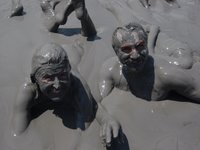Martinique
After a brisk sail to Martinique we arrived at the famous town of St. Pierre. A very pretty place that was, mostly, destroyed in 1902 when Mt. Pelee erupted and released a fireball and superheated gas onto the city below. Logically, it should have been evacuated earlier due to the numerous warning signs. However, the Mayor at the time was persuaded, by wealthy landowners, that this happens often and the problem would go away. Evacuation would leave there land exposed to looters and squatters. As a result about 30,000 people died and only two survived. They were Leon Leandre, a cobbler who was in his stone cellar at the time, and the infamous murderer Cyparis, imprisoned in a stone cell at the time.In town we saw many of the ruins still standing, in some cases they often shared a wall with a new structure. Financial constraints prevented us from touring the island but we did explore the town, museum, craft center, and a local plantation/distillery which had some of the worst rum I’ve ever tasted. The French islands, in general, produce the worst rum of the Caribbean. Compared to the Spanish islands it’s like rough moonshine and has a weird smell to boot. Nonetheless, we managed to party a bit with several other familiar crews in the anchorage beneath the lush green backdrop of the surrounding hills.
Fort De France was our next port of call as there was a Rastafarian gathering over the weekend and promised to be loads of fun. Anchoring off the new cruise ship was not an easy matter and required several attempts to find a spot with enough sand for the anchor to bite. Once we were holding well I decided to dive on the anchor and be sure. We had stuck fast onto a massive I beam from the demolition of the old dock. Construction debris was scattered everywhere. We were pretty close to the shore and associated noise but, anchoring further out wasn’t an option due to the sharp drop off.
We quickly got the dinghy lowered and headed into the festival amongst the aroma of ganja, the smell of spiced food, and the loud, French, Rastafarian band jamming on stage. The food was mostly organically produced and tasted great, such a variety. Several craft stall offered locally made items of various price ranges and quality. It’s amazing what can be produced from cocoanut shells. Later that evening the band was still jamming but we retired to a nice café and enjoyed an aperitif and espresso whilst watching the sunset through the haze of medicinal properties before quitting for the evening.
Marin anchorage. Why on earth we stopped here eludes me at the moment. I seem to recall we needed extra supplies or something. It’s quite a dump to hangout in for any length of time. It’s a major center for the charter boat companies with obligatory, dry-docks, haul outs, shipping, tourist facilities at very high prices and lots of bugs. It’s, basically, a marshland anchorage in a river delta that can be a bugger in a heavy downpour. Not to worry, weather looks fine, right! Wrong. Before we could leave a huge storm came and sat on top of us and proceeded to drench us for the following 48 hours. Of course the creeks and river swelled to maximum capacity and dumped their contents, at high velocity, into the bay. Where is the designated anchorage? Why right at the river mouth of course.
Now, apart from the 4-5 knots of water pouring out of the river we also had the associated, accumulative, dry season detritus and debris. Our hull was exposed to a refrigerator, children’s toys, barrels, fuel drums, plastic of all sorts, bamboo, trees, logs, and the usual household waste. The bay had turned into a black cesspool which threatened to block your engine intake should you your motor. T o make matters worse the wind was blowing at 30 knots from the opposite direction and created quite a chop in the bay. This contrary situation also caused boats to lay in varying orientations depending on their windage and size. Unfortunately we were anchored next to a large trawler who responded more to the prevailing wind conditions, than current, and ended up against. Purely my fault as we anchored there after he did. I offered to move but, under the circumstances it would be difficult so we put out fenders and adjusted our anchor rodes enough to prevent an damage.
Once the weather had cleared we had an opportunity to watch the, “Dockwise” , yacht transporter in action. Basically it’s a floating, lidless, container that opens it’s rear doors, and submerges enough for boats to drive in through the rear. Divers then attach frames to the ships deck and support each boat. When done, they close the doors, pump out the water and sail away with the boats inside and lots of masts sticking up. Very cool stuff but, not cheap. We asked one owner about the cost and he had paid $US14,000 from Martinique to France. However, you can travel inside your yacht for the journey, conduct maintenance, repairs, and even a bottom job!


0 Comments:
Post a Comment
<< Home